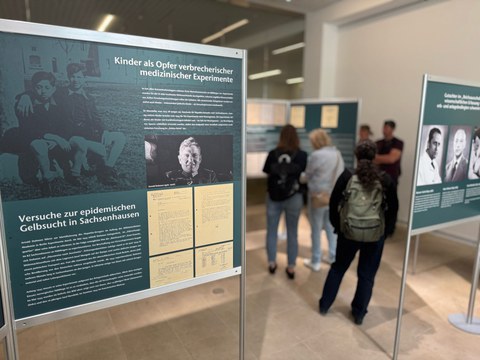Sep 29, 2025
Exhibition "In memory of the children" in review: Focus on Nazi crimes against children

The exhibition "In memory of the children" was shown in Dresden's Dreikönigskirche from April to July.
The traveling exhibition "In Memory of the Children" focuses on a particularly harrowing chapter of medical crimes under National Socialism: the systematic murder of children with mental and physical disabilities. It was on display for two months in the Dreikönigskirche in Dresden and met with a great response. In this article, Dr. Marina Lienert, Research Associate at the Institute of History of Medicine at TU Dresden, looks back on the impact of the exhibition.
The Institute of History of Medicine was instrumental in the conception of the Dresden station. At each exhibition location, local researchers supplement the exhibition with regional references. In Dresden, institutions and individuals involved in organized infanticide were presented, as well as children who became murder victims. As the involvement of Dresden's stakeholders has not yet been sufficiently investigated, it was first necessary to review and evaluate extensive archival material. The Saxon Memorials Foundation provided support with this. The Institute's staff then produced four panels summarizing the results of their research.
A special educational offer was aimed at school classes in grades 11 and 12: the pupils created podcasts in which they dealt with various aspects of the child murders. The podcasts, which lasted around eight minutes, shed light on the perpetrators and institutions, bureaucratic concealment methods and the perspectives of the victims and their families.
The exhibition is firmly embedded in the historical context of the city of Dresden. During the Nazi era, Dresden was considered a stronghold of National Socialist health and population policy and aspired to the title of "City of Public Health". The Deutsches Hygiene-Museum played a central propaganda role in this. The children's clinic at Dresden-Johannstadt City Hospital, the largest of its kind in the region, reported affected children to the city health department, thereby initiating the bureaucratic procedure for infanticide. In addition, children were killed in a targeted manner through non-treatment, neglect and medication. The medical records document these acts in frighteningly clear language. Some excerpts were shown in the exhibition.
This dark chapter is also addressed in the medical curriculum at TU Dresden. The patient murders are dealt with in detail as part of the courses in the cross-sectional area "History, Theory, Ethics of Medicine" (GTE). A visit to the Pirna-Sonnenstein memorial is an integral part of teaching for all students and deepens the knowledge imparted.
The exhibition has made an important contribution to Dresden's culture of remembrance. In addition to the high number of visitors, the accompanying program, the coverage in daily newspapers and specialist media as well as the podcast "You ask - we explain" contributed to broad public awareness. The entries in the guest book testify to the concern of many visitors. For some of them, it was the first time they had come to terms with this period of the city's history. Numerous people expressed their dismay at the crimes, their grief for the victims and their displeasure at the fact that many perpetrators were able to continue working as paediatricians and in nursing after 1945 without any consequences. At the same time, it was emphasized how important it is to remember - especially today and here. The task remains to give the murdered children their rightful place in the collective memory of Nazi crimes.
The exhibition is also accessible digitally. Further exhibition locations will be announced on the website of the German Society for Pediatric and Adolescent Medicine.
